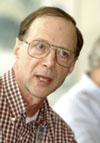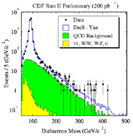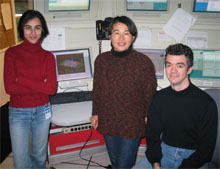 | Thursday, February 5, 2004 |
|
Thursday, February 5 2:30 Theoretical Physics Seminar - Speaker: S. Fleming, Carnegie Mellon University Title: Lessons from Soft-Collinear Effective Theory 3:30 DIRECTOR'S COFFEE BREAK - 2nd Flr X-Over 4:00 Accelerator Physics and Technology Seminar - 1 West Speaker: K. Shepard, Argonne National Laboratory Title: Superconducting RF Technology for Ion Accelerators
Friday, February 6 |
|
Wednesday, February 4 Wild Mushroom Bisque Baked lemon rosemary chicken w/wild rice and choice of vegetable $4.75 Turkey, roast beef and smoked bacon w/cheddar cheese on your choice of bread served w/a side salad $4.75 Farfalle pasta w/wild mushroom sauce $3.50 1/2 pound burger w/bleu cheese and bacon on a cornduster roll $4.75 Hand rolled Hanabi sushi Eurest Dining Center Weekly Menu Chez Leon |
|
Extended Forecast |
Secon Level 3 |
| Fermilab Today is online at: http://www.fnal.gov/today/ Send comments and suggestions to today@fnal.gov Fermilab Today archive Fermilab Today classifieds Subscribe/Unsubscribe to |
|
Boris Kayser Named Editor of Annual Review of Nuclear and Particle Science | ||
|
Fermilab scientist Boris Kayser, a theorist whose interests include neutrino physics and CP violation, has been named editor of the Annual Review of Nuclear and Particle Science. Kayser succeeds outgoing editor and Fermilab colleague Chris Quigg.
"The articles should give people a clear introduction to a topic," explains Kayser. "I agree with Chris Quigg that the Annual Reviews should be the first place you'd send a student or someone new to a scientific field to learn about it."
|
|
February 2 - February 4 - During this period of time Operations established two stores. These stores provided the experiments with approximately thirty-seven hours and 32 minutes of luminosity. - The Fermi accelerators set two new luminosity records with both stores. The record is now 55.5E30. - Switchyard experts successful in sending beam to the Switchyard dump.
View the current accelerator update |
| From The American Institute of Physics Bulletin of Science Policy News (Number 10; February 4, 2004) Bush Administration Sends FY 2005 Budget to Congress Characterizing the FY 2005 science and technology budget request that was sent to Congress on Monday is a classic example of a glass being viewed as half-full or half-empty. Although some components of the S&T budget request are up, others are down, or at least disappointing. Contrast the remarks made by OSTP Director John Marburger: "I think we have a good story here," with those of House Science Committee Chairman Sherwood Boehlert (R-NY) who said, "I am very disappointed in the proposed science budget . . . we just have to find a way to do better."
There are many different perspectives by which to view the S&T budget request. Faced with mounting deficits, the Bush Administration restrained future growth in discretionary program
spending. These are the programs for which funding can vary each year, such as for S&T, as compared to, for example, mandated expenditures for Social Security. Not counting discretionary
spending for defense and homeland security programs, discretionary programs account for less than one-fifth of the total federal budget. The Administration proposes to limit to just 0.5% the
overall increase for this portion of the budget.
Further declarations on international scientific cooperation for sustainable development, neuroinformatics and high energy physics were also adopted at the same meeting of the Organisation for Economic Cooperation and Development (OECD) committee for scientific and technological policy on 29 and 30 January. Ministers recognised that open access to data, information and knowledge 'contributes decisively to the advancement of scientific research and innovation' and 'maximise[s] the value derived from public investments in data collection'.
They therefore concluded that open and transparent methods for accessing research data should be created, either by strengthening existing instruments, or by establishing new mechanisms for collaboration. Achieving this aim whilst ensuring the protection of intellectual property and trade secrets was highlighted as a priority.
|
| CDF Searches for the Unknown in High-mass Dileptons
This comparison is more certain for lepton pairs: the jet of particles associated with quarks muddies both predicted and observed spectra. This has motivated a group of CDF collaborators to search for these effects using electron and muon pairs. An improved silicon detector, more efficient data collection and better analysis techniques combine to capture more of these interactions than in RunI, increasing sensitivity significantly. Run II results, still preliminary but nearing completion, explore many alternate theoretical predictions, including large extra dimensions, technicolor, R-parity violating SUSY, Randall-Sundrum gravitons, and the Z' that occur in E6 and Little Higgs models. While the data is currently consistent with the Standard Model prediction, more Tevatron data may yet reveal surprises. | ||
|
Result of the Week Archive |
|
Barn Dancing Fermilab Barn Dance Sunday, Feb. 8 at 6:30 p.m., with The Dust Devils and calling by Tony Scarimbolo. Dances are held in the Warrenville Community Building, 3S240 Warren Ave., Warrenville. See http://www.fnal.gov/orgs/folkclub/ for more info.
Prescription Safety Glass Program
Folk Dancing |



